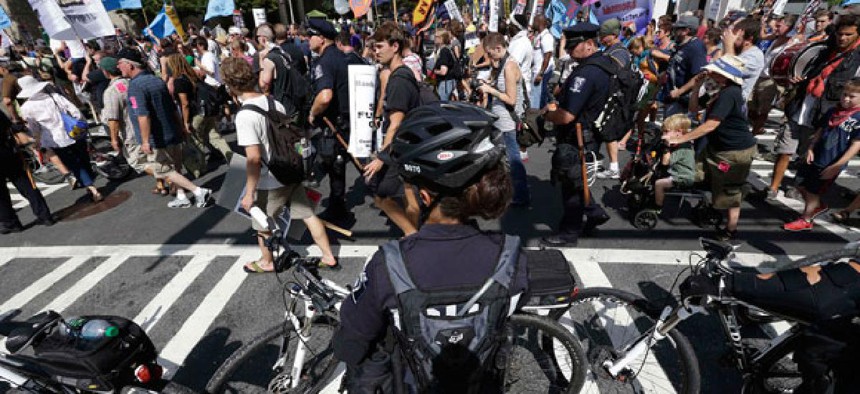
Police observe protestors Monday in Charlotte. Patrick Semansky/AP
Protesters, security forces clash in Charlotte
Standoff blocks roads that were not expected to be closed.
Rowdy protesters and stepped-up security wreaked havoc in uptown Charlotte on the first day of the Democratic National Convention.
For several hours in the afternoon, a standoff between police and protesters identifying themselves with the Occupy movement blocked roads that were originally not expected to be closed. This exacerbated traffic problems, stranding or delaying some delegates and even other demonstrators.
“I’ve been trying to get into this area for 45 minutes,” said Washington Mayor Vincent Gray, one of the delegates. He ran into trouble both driving and walking while trying to get to the convention for another rally for D.C. statehood.
“We could drive up to a certain point, and then we had to walk down a couple blocks, up a couple blocks, down three blocks and, of course, ironically enough, when we got here, it was over,” Gray said in a tired, exasperated tone.
The group of about 50 protesters wanted to march down Stonewall Street, which borders the convention center and is a few blocks from the Time Warner Cable Arena, but police say they stopped the demonstrators because they were blocking traffic. After a standoff that lasted at least two hours, Charlotte-Mecklenberg Police Chief Rodney Monroe summoned a protester to a meeting that took about 10 minutes and ended with an agreement that if protesters confined themselves to the sidewalk they would be allowed to march.
It was then that the clashes between protesters and conventioneers got personal. Police broke up a heated exchange between two Nevada delegates and at least one protester. The confrontation happened as the delegates and a much smaller crowd of activists passed each other on the sidewalk.
“I’m proud to be a Democrat, period,” delegate JoEtta Brown said as police escorted her away from the protesters. It was unclear what the protesters and delegates were arguing about except the general notion that the demonstrators were unhappy with President Obama and the Democratic Party writ large.
Just one more block down Stonewall Street, another shouting match broke out between a protester and convention guests Ronald Mincey and Ruth Richards. “The only time we see you is at stuff like this,” Mincey yelled at the protester, 20-year-old Matthew Malone. Malone and many of the others there were protesting to support Bradley Manning, an Army soldier who was arrested in May 2010 on suspicion of having passed classified material to WikiLeaks, the whistle-blower website.
Despite the disturbances, Charlotte police had arrested only three people as of 5 p.m.—and two of the arrests weren’t related to the standoff. Two men were arrested on charges of disrupting a National Journal event earlier on Tuesday. Another man was taken into custody near the standoff area for breaching a police line and barricade.
Many conventioneers were already grappling with logistical difficulties.
“They wouldn’t let us walk on Martin Luther King Jr. Boulevard,” said Pam Douglas, who was attending the convention as part of the California Correctional Peace Officers Association. But the problems she faced were not a result of the protests. They were “just because of the way they did the strategic planning,” Douglas said bitterly while waiting for the police to allow her to pass the protesters to get to her hotel, the Hampton Inn, on the other side of the standoff.
People’s experiences getting around Charlotte varied, depending on how and when they reached the security-laden uptown area. Convention-goers who took public transportation, such as the rail system Lynx, said the trip didn’t take long at all. But those trying to get from one point to another within the uptown area said it took hours to go just a few miles.
“We’re dealing with a smaller geographical area than in years past, and that has its benefits and burdens,” said Manny Ortiz, who was at the convention with consulting and lobbying firm Brownstein Hyatt. “Benefits are, your distances are closer, but you’re all stacked together, and there’s a lot of foot traffic.”
Ortiz, who was trying to get out of the uptown area, added, “Something like this—a protest—that blocks the only access road you have to your bus makes it even worse.”






